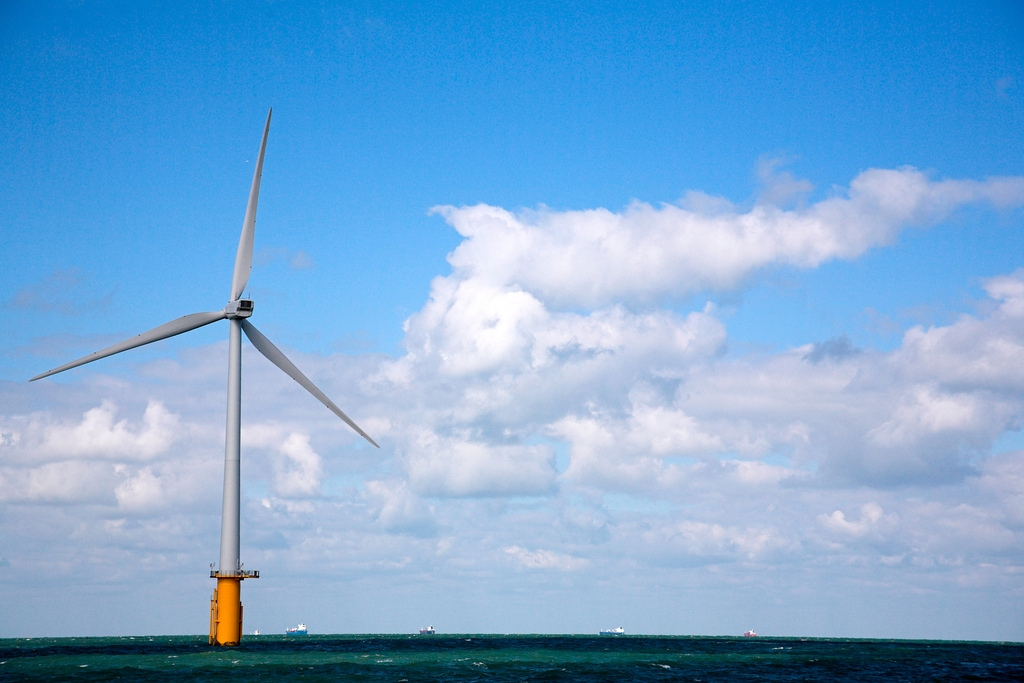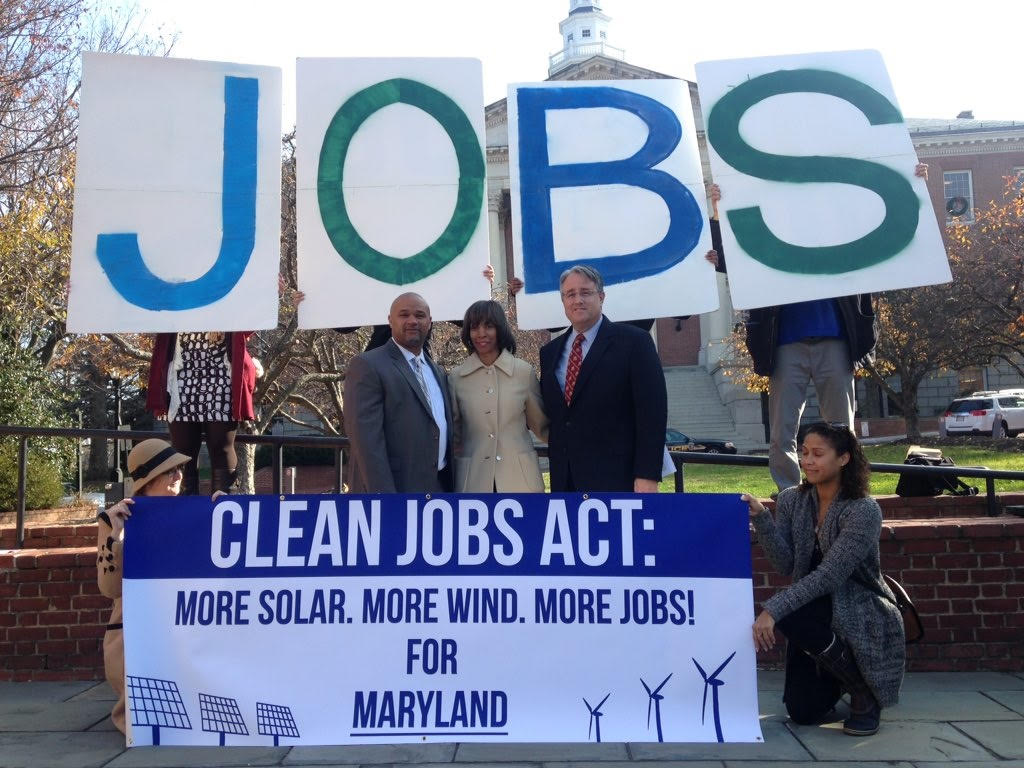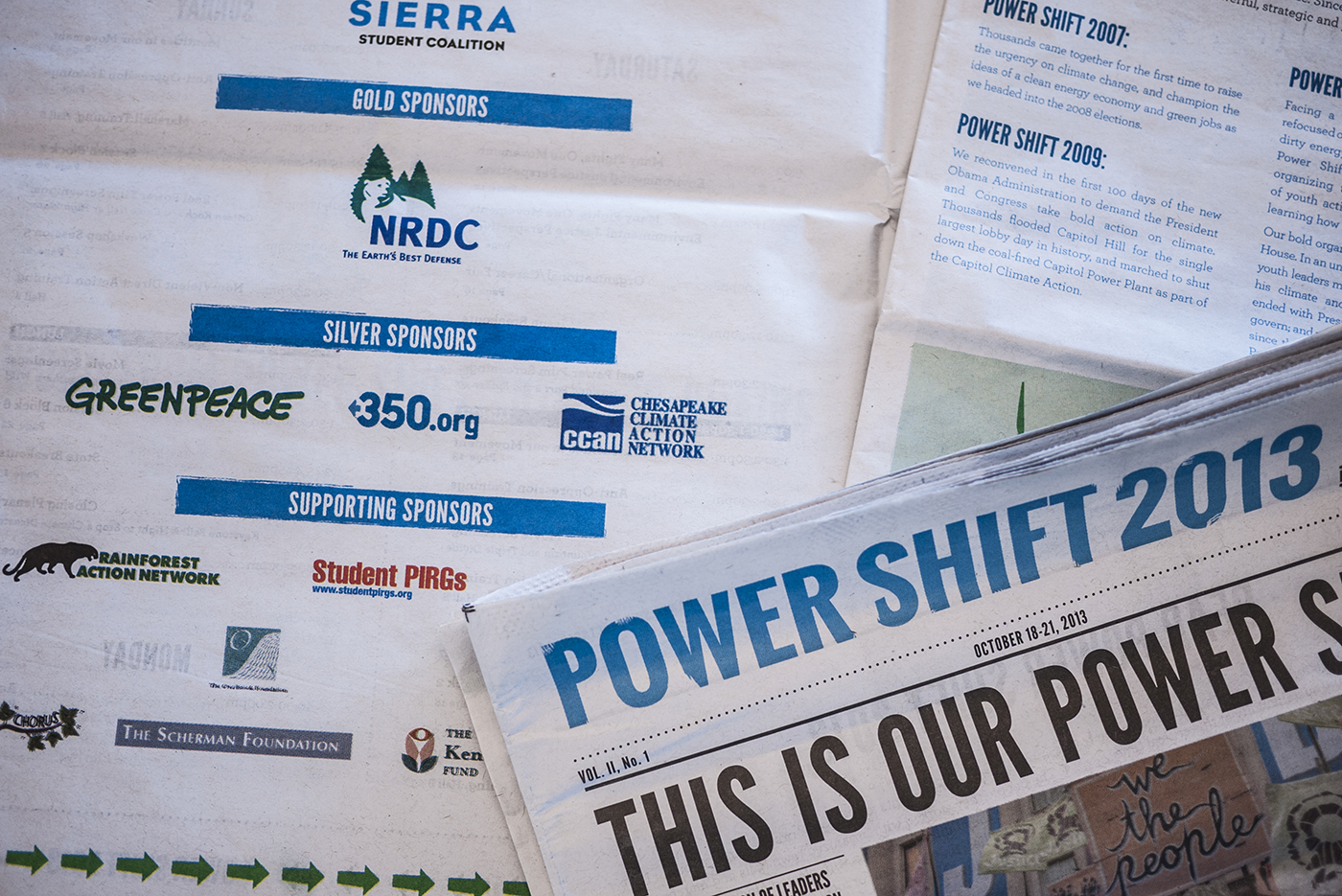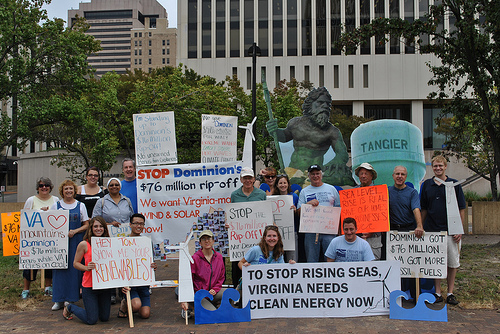
My second week at CCAN I stood knee deep in the Baltimore Harbor in a dress and waders cleaning up debris that the tide had washed in. I knew at that moment that I had joined an organization that would do anything to bring clean energy to Maryland. That morning, Mike Tidwell, CCAN’s director, stood waist-deep in the Inner Harbor along with members of the Sierra Club, Working Families, the MD State Chapter of the NAACP, faith and student leaders to show why clean energy was desperately needed in Maryland.
As a broad, diverse coalition spoke behind a podium immersed in water — we began our journey to fight for a 40% clean energy standard in Maryland. The initiative was bold, innovative — yet not impossible. It would take all of us across Maryland working together for years to raise Maryland’s clean energy standard.
We are proud to announce that we have had a momentous year for climate change legislation in Maryland. Governor Hogan signed into law the Greenhouse Gas Reduction Act that will slash emissions by 40% by the year 2030. On Monday, April 11th, on the final day of the 2016 session, the Clean Energy Jobs Act passed the Maryland General Assembly. The Clean Energy Jobs Act raises Maryland’s clean electricity standard to 25% by 2020 and opens up new avenues of funding for minority, small and women-owned businesses in the renewable energy industry. The Clean Energy Jobs Act will ensure that Maryland keeps dirty fossil fuels in the ground while diversifying and expanding Maryland’s wind and solar industry.
For those of you that have worked alongside us for the past few years — you know that these victories did not come easily. It took all of us working together and exploring bold new ways to secure a clean energy future for Maryland.
On the opening day of session in 2015, over 200 activists stood out in the bitter, January cold, holding wind turbines and placards demanding a clean energy future for Maryland. Lawyer’s Mall was crowded with legislative champions Senators Feldman and Madaleno along with labor, civil rights, health and faith voices. Trisha Sheehan, of Mom’s Clean Air Force stated, “Children are among the most vulnerable to climate change, especially from extreme heat events, widespread disease and increased air pollution. Maryland has the ability to double its use of clean energy by 2025. We need to act now to cut our reliance on the dirty fossil fuels that are polluting our air and making us sick.”
turbines and placards demanding a clean energy future for Maryland. Lawyer’s Mall was crowded with legislative champions Senators Feldman and Madaleno along with labor, civil rights, health and faith voices. Trisha Sheehan, of Mom’s Clean Air Force stated, “Children are among the most vulnerable to climate change, especially from extreme heat events, widespread disease and increased air pollution. Maryland has the ability to double its use of clean energy by 2025. We need to act now to cut our reliance on the dirty fossil fuels that are polluting our air and making us sick.”
We worked hard throughout the session to show legislators that reaching a 40% clean energy standard was an achievable goal. A goal that was not only supported by environmentalists — yet was a vital component of our state’s pursuit towards achieving a higher standard of public health, economic well-being and to turn the tide on the injustices that the fossil fuel industry had wrought on low-income and minority communities.
Over a hundred activists gathered once again in Annapolis to meet with their legislators and rally through the  night in February of 2015. Despite the tremendous show of support we ultimately did not pass clean energy legislation in the 2015 session. Legislators balked at the idea of a 40% goal and instead we began to work on a 25% by 2020 standard. We knew that if we hit this critical benchmark that it would put us on the trajectory to achieve a 40% clean energy standard by the year 2025, and we could truly double wind and solar in Maryland. The bill failed in the Senate Finance Committee — yet the result of all of our efforts was that we built an unshakeable foundation and garnered the support of powerful Senate leaders and built a groundswell of grassroots activists.
night in February of 2015. Despite the tremendous show of support we ultimately did not pass clean energy legislation in the 2015 session. Legislators balked at the idea of a 40% goal and instead we began to work on a 25% by 2020 standard. We knew that if we hit this critical benchmark that it would put us on the trajectory to achieve a 40% clean energy standard by the year 2025, and we could truly double wind and solar in Maryland. The bill failed in the Senate Finance Committee — yet the result of all of our efforts was that we built an unshakeable foundation and garnered the support of powerful Senate leaders and built a groundswell of grassroots activists.
After the 2015 session, we did not rest. Instead we continued to work so that we would flood Annapolis with voices from across Maryland. In September, Pope Francis arrived in D.C. with a message for people of faith and conscious, “Never have we so hurt and mistreated our common home as we have in the last 200 years….Yet all is not lost. Human beings, while capable of the worst, are also capable of rising above themselves, choosing again what is good, and making a new start.”
 Faith communities across Maryland answered the Pope’s call to care for creation. Together with Interfaith Power and Light, the Chesapeake Climate Action Network hosted “Climate in the Pulpits” — a statewide effort of faith communities to raise up creation care and climate change in their worship services. On the weekend of September 23rd, over 87 congregations celebrated Climate in the Pulpits by inviting climate activists to give sermons, dedicating their worship message to climate change and signing postcards to their legislators urging them to pass the Greenhouse Gas Reduction Act and the Clean Energy Jobs Act. Maryland State Delegate Dereck Davis (D-25 Prince George’s) participated by speaking on clean energy during the Sunday service at Forestville New Redeemer Baptist Church in District Heights. “Pope Francis has reminded us that addressing climate change is one of the great moral issues of our time,” said Del. Davis. “It is imperative that Maryland acts on climate so that we can create real, broad, and sustainable prosperity.”
Faith communities across Maryland answered the Pope’s call to care for creation. Together with Interfaith Power and Light, the Chesapeake Climate Action Network hosted “Climate in the Pulpits” — a statewide effort of faith communities to raise up creation care and climate change in their worship services. On the weekend of September 23rd, over 87 congregations celebrated Climate in the Pulpits by inviting climate activists to give sermons, dedicating their worship message to climate change and signing postcards to their legislators urging them to pass the Greenhouse Gas Reduction Act and the Clean Energy Jobs Act. Maryland State Delegate Dereck Davis (D-25 Prince George’s) participated by speaking on clean energy during the Sunday service at Forestville New Redeemer Baptist Church in District Heights. “Pope Francis has reminded us that addressing climate change is one of the great moral issues of our time,” said Del. Davis. “It is imperative that Maryland acts on climate so that we can create real, broad, and sustainable prosperity.”
Communities across Maryland also spoke out for the Maryland Greenhouse Gas Emissions Reduction Act (GGRA) — Maryland’s legal mandate to curb greenhouse gas emissions which was set to expire in 2016. The Maryland Climate Commission held meetings across the state from the Eastern Shore to Frostburg, MD. Activists told the Maryland Climate Commission members that not only did they want the to renew the GGRA, they also wanted to strengthen the benchmarks and goals, in order to address the growing threat of climate change.
Next, CCAN and the Maryland Climate Coalition hit the road and embarked on our Energy, Health, and Climate Expo tour throughout Maryland to build a strong alliance of clean energy advocates across the state. Events were held in Baltimore City/County, Charles County, Harford, and Howard Counties. Each event featured our clean energy champions from across the state including — Senator Middleton, Delegate Davis, Delegate Brooks, Delegate Robinson, Maryland Congresswoman Donna Edwards, and spokespeople from Maryland Congressman Chris Van Hollen’s office. Green organizations came together to teach community members about sustainability and how we can work together to combat the growing threat of climate change. This effort culminated in growing our grassroots movement and increased the amount of minorities and low-income community members engaging in our campaigns and advocating for clean energy policies in Maryland.
At the start of the 2016 session, we gained a powerful ally in Maryland State Senator Catherine Pugh, who introduced the  Clean Energy Jobs Act — a bill with a landmark $40 million investment in workforce development and grants for small, minority, and women-owned businesses in the renewable energy industry. On the first day of session, Senator Pugh, lead sponsor of the Clean Energy Jobs Act, gathered with key committee leaders at a press conference in support of the Clean Energy Jobs Act and stated, “We’ll grow Maryland’s clean energy economy in a way that increases the diversity of workers and business owners. As we create more than 1,000 new solar jobs per year, we’ll also give more Marylanders pathways to good-paying careers.”
Clean Energy Jobs Act — a bill with a landmark $40 million investment in workforce development and grants for small, minority, and women-owned businesses in the renewable energy industry. On the first day of session, Senator Pugh, lead sponsor of the Clean Energy Jobs Act, gathered with key committee leaders at a press conference in support of the Clean Energy Jobs Act and stated, “We’ll grow Maryland’s clean energy economy in a way that increases the diversity of workers and business owners. As we create more than 1,000 new solar jobs per year, we’ll also give more Marylanders pathways to good-paying careers.”
Throughout the 2016 legislative session our activists never let up. After record-setting blizzard Jonas, our activists dug themselves out and attended lobby days urging their legislators to vote YES on both the Greenhouse Gas Reduction Act and the Clean Energy Jobs Act. Over the course of the last four months we held over a hundred legislative meetings with many grassroots advocates lobbying for the first time. Tracey Waite, founder of Harford County Climate Action and first time grassroots lobbyist said to one staffer, “When I think about climate change and our future, I feel as if I am in a boat and it has all these holes in it. If someone doesn’t plug the holes then this boat is going to sink. You have the power with both of these bills to stop the ship from sinking, Will you support these bills?”
 On March 17, the Maryland General Assembly approved the landmark Greenhouse Gas Emissions Reduction Act of 2016. The bill, SB 323/HB 610, renews the 2009 Maryland law that set a goal to reduce climate-polluting greenhouse gas emissions statewide by 25 percent by 2020. The 2016 bill further extends the goal to a 40 percent reduction by 2030, requiring deep, long-term cuts in pollution. It received final approval by the House of Delegates after the Senate approved the bill in a 38-8 bipartisan vote in late February.
On March 17, the Maryland General Assembly approved the landmark Greenhouse Gas Emissions Reduction Act of 2016. The bill, SB 323/HB 610, renews the 2009 Maryland law that set a goal to reduce climate-polluting greenhouse gas emissions statewide by 25 percent by 2020. The 2016 bill further extends the goal to a 40 percent reduction by 2030, requiring deep, long-term cuts in pollution. It received final approval by the House of Delegates after the Senate approved the bill in a 38-8 bipartisan vote in late February.
The Greenhouse Gas Reduction Act commits Maryland to one of the highest climate goals in the country, following California and New York.
Following this victory, Mike Tidwell proclaimed, “This bold, and strikingly bipartisan, commitment to stronger climate action will help protect Maryland’s economy, health, and increasingly flooded shoreline. Our climate-vulnerable state is now leading the way, showing that reducing carbon pollution is not a partisan question, but an urgent necessity.”
And in the final hours of the 2016 Maryland General Assembly, the Clean Energy Jobs Act was sent to Governor Hogan’s desk. The Clean Energy Jobs Act passed with an overwhelming bi-partisan majority of members of the House of Delegates with a vote of 92-43 and in the Senate with a vote of 31-14. Lead Senate Sponsor, Catherine Pugh stated, “This vote is a major step toward growing Maryland’s clean energy economy. This bill will create good-paying jobs and healthier air for communities in Baltimore and across Maryland that urgently need both.”
The journey that started with an underwater press conference in Baltimore City has now spread across the state of Maryland. Thanks to all of you that have made this possible and let’s continue to win more victories for Maryland, for our climate, and for our future.






 turbines and placards demanding a clean energy future for Maryland. Lawyer’s Mall was crowded with legislative champions Senators Feldman and Madaleno along with labor, civil rights, health and faith voices. Trisha Sheehan, of Mom’s Clean Air Force stated, “Children are among the most vulnerable to climate change, especially from extreme heat events, widespread disease and increased air pollution. Maryland has the ability to double its use of clean energy by 2025. We need to act now to cut our reliance on the dirty fossil fuels that are polluting our air and making us sick.”
turbines and placards demanding a clean energy future for Maryland. Lawyer’s Mall was crowded with legislative champions Senators Feldman and Madaleno along with labor, civil rights, health and faith voices. Trisha Sheehan, of Mom’s Clean Air Force stated, “Children are among the most vulnerable to climate change, especially from extreme heat events, widespread disease and increased air pollution. Maryland has the ability to double its use of clean energy by 2025. We need to act now to cut our reliance on the dirty fossil fuels that are polluting our air and making us sick.”






